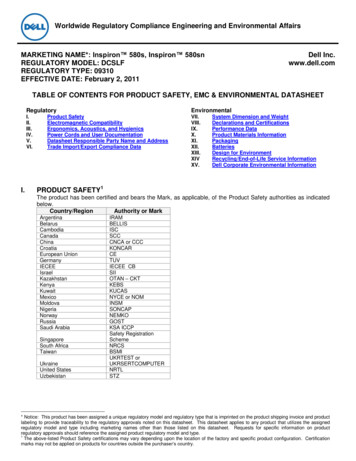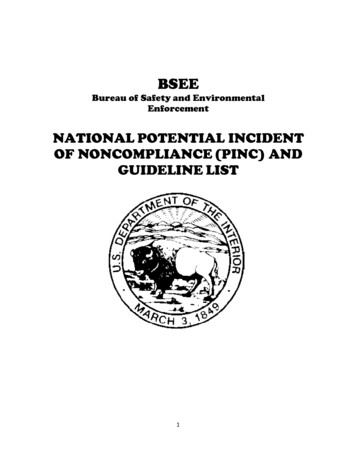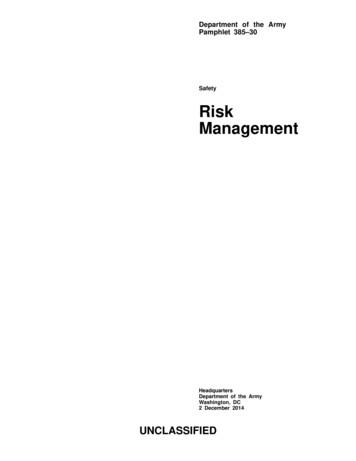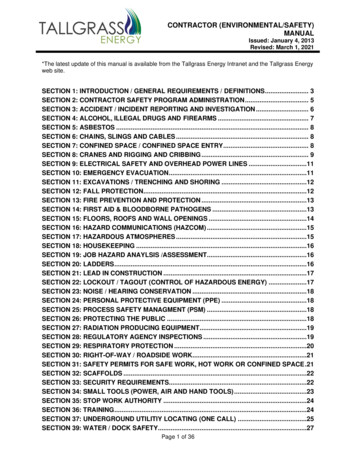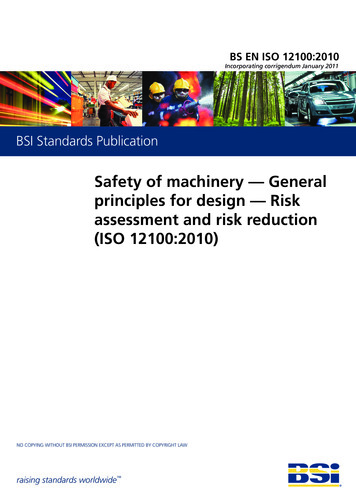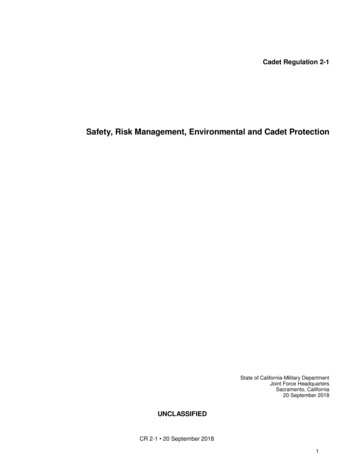
Transcription
Cadet Regulation 2-1Safety, Risk Management, Environmental and Cadet ProtectionState of California-Military DepartmentJoint Force HeadquartersSacramento, California20 September 2018UNCLASSIFIEDCR 2-1 20 September 20181
SUMMARY of CHANGECR 2-1Safety, Risk Management, Environmental, and Cadet ProtectionThis is a major update to a previously published regulation to include:oAddition of figures detailing Heat and Cold Training safety concernsoAddition of figure detailing risk assessment matrixoGuidance for transgender cadetsoGuidance for cyberbullyingoGuidance for electronic communication between adults and cadetsoInclusion of the Cadet Protection PolicyCR 2-1 20 September 20182
Cadet Regulation 2-1State of California – Military DepartmentJoint Force HeadquartersHeadquarters, California Cadet CorpsSacramento, CaliforniaEffective 20 SEP 2018Safety, Risk Management, and Environmental Protectiondelegate this approval authority, in writing, to a HQCACCstaff officer or State Projects Officer. Activities or unitsmay request a waiver to this regulation by providing fulljustification that includes a full analysis of the expectedbenefits. All waiver requests will be endorsed by thesenior commandant officer of the requesting activity orunit and forwarded through their higher headquarters tothe policy proponent.When these regulations are inconflict with local school or district policies, the morerestrictive of the two policies shall be used.DAVID S. BALDWINMajor GeneralThe Adjutant GeneralOfficial:GRACE E. EDINBOROColonel, CACCExecutive OfficerHistory.This is significant update to a previouslypublished regulation.Summary.This regulation provides guidance forincluding safety, youth protection, risk management, andenvironmental protection into training and operationswithin the California Cadet Corps.Applicability.This regulation applies to allcommandant and cadet personnel in active service orenrollment with the California Cadet Corps. It applies toall units organized within the California Cadet Corps.Proponent and exception authority. The proponentof this regulation is the Executive Officer, CaliforniaCadet Corps. The proponent has the authority to approveexceptions or waivers to this regulation that are consistentwith controlling law and regulations. The proponent maySupplementation. Supplementation of this regulationand establishment of command and local forms areprohibited without prior approval, in writing, from theExecutive Officer, California Cadet Corps. Send a draftcopy of each supplement to Youth Programs, CaliforniaCadet Corps, ATTN: Executive Officer, Building 1301,Camp San Luis Obispo, CA.Suggested improvements. Users are invited to sendcomments and suggested improvements in memorandumform directly to the address listed above.Distribution. This publication is available in electronicmedia only and is intended for all levels of the CaliforniaCadet Corps organization and is authorized for publicdistribution. Printed copies of this publication may beprovided, within budget limitations, at the discretion ofthe Joint Force Headquarters, California (HQ CACC).CR 2-1 20 September 2018i
Contents (Listed by paragraph and page number)Chapter 1, Introduction1-1. Purpose and Authority, page 11-2. References and Definitions, page 11-3. Responsibilities, page 2Chapter 2, Safety in Training and Training Safely2-1. General, page 32-2. Safety in Training Relative to the CACC Standards, page 32-3. Safety considerations at typical cadet training events and operations, page 3Chapter 3, Risk Management3-1. Fundamentals, page 73-2. The Risk Management Process, page 7Chapter 4, Environmental Protection4-1. General, page 94-2. Guiding Principles, page 94-3. Principles in Practice, page 9Chapter 5, The Risk Management Worksheet5-1. General, page 105-2. Completing the Worksheet, page 10Chapter 6, Cadet Protection6-1. General, page 116-2. Key Organizational Policies, page 116-3. Decorum and Fraternization, page 116-4. Universal Standards of Practice, page 126-5. Alignment of Training Goals and Training Intensities, page 136-6. Reporting Requirements, page 136-7. Investigations, page 14Figures2-1. Work/Rest Times & Fluid Replacement Guide, page 62-2. Cold Weather Training, page 63-1. Risk Management Table, page 8AppendicesA. Form 203, Report of Medical History, page 15B. Form 21, Risk Management Worksheet, page 17CR 2-1 20 September 2018ii
Chapter 1Introduction1-1. Purpose and Authority.Section 501, California Military and Veteran's Code provides that “Cadet companies shall at all times beunder the guidance and control of the principal, president, director or chief administrative officer of thecollege, community college or high school, whose duty it shall be to make regulations with the approvalof the Adjutant General regarding the moral, educational, and physical welfare of the cadets.” Thisregulation sets forth guidance on how California Cadet Corps units shall plan, implement, and evaluatetraining so as to maximize safety, mitigate and manage risk, and maintain maximum protection of theenvironment.1-2. References and Definitions.a. Reference Dept. of the Army Pamphlet 385-10, Army Safety Program,, dated 23 May 2008 and ATP5-19, Risk Management, dated 14 April 2014.b. The following definitions are used in this regulation.(1) Hazard. Any actual or potential condition that can cause injury, illness, or death topersonnel, or damage to or loss of equipment/property.(2) Risk. The probability of exposure to injury or loss from a hazard.(3) Risk Assessment. The identification and assessment of hazards, setting of values on riskelements, comparing risks against training benefits, and eliminating unnecessary risks.(4) Safety in Training. What we train in terms of prevention and risk control.(5) Training Safely. How we train by identifying the hazards and integrating safety intotraining practice.(6) Training vs. Operations. Training events are events at which cadets primarily learn newmaterial (such as at a leadership school or bivouac). Operations are events at which cadetscompete (general Drill Competitions, IMAs, rifle matches, etc.) or provide support (School andcommunity service, CERT, etc.)(7) Abuse. California State law defines child abuse as (a) physical injury inflicted on a child byanother person, (b) sexual abuse, or (c) emotional abuse. Child neglect is defined as negligenttreatment which threatens the child's health or welfare. See (CPC 11164)(i) Actions can violate this policy without rising to actual abuse. See “boundaryconcerns” in paragraphs 1-2(11) of this regulation.(ii) In CACC’s military-style training environment, it is important to distinguishemotional abuse, which by definition inflicts serious harm, from an inappropriately hightraining intensity, which though momentarily unpleasant is not abusive because it doesnot inflict serious harm. See Chapter 6 of this regulation for guidance on trainingintensity(8) Sexual Abuse. Building upon the definition of “abuse” in the paragraph above, cadet sexualabuse includes:(i) All sexual contact between an adult leader/volunteer/chaperone, and a cadet,regardless of whether there is deception or the cadet understands the sexual nature of theactivity is a violation of the law.(ii) Sexual contact that is accomplished by force or threat of force, regardless of the ageof the participants.(iii) Sexual contact between an older and a younger cadet if there is a significantdisparity in age, development, or size, rendering the younger cadet incapable of givinginformed consent and(iv) Sexual penetration, sexual touching, or non-contact sexual acts such as exposure orvoyeurism.CR 2-1 20 September 20181
(9) Reasonable Suspicion of Abuse. A CACC member may form a reasonable suspicion ofabuse when two factors are present: first, the member has specific, credible information that acadet has been hurt or harmed by another person, and second, another experienced adult leaderwould suspect abuse if given the same information. It is possible to have a reasonable suspicionof abuse without having proof of abuse.(10) Hazing and Bullying. Hazing and bullying are defined as any conduct whereby someonecauses another person to suffer or to be exposed to any activity that is cruel, abusive, humiliating,oppressive, demeaning, harmful, or coercive against one’s will.(i) By definition, hazing and bullying are forms of abuse.(ii) Questions of hazing often pertain to the intensity level of military-style training incadet programs. Training intensity is evaluated in context. For example, a trainingintensity that is too stern and demanding in class at school may be appropriate at someHQS CACC events.(iii) Cyberbullying is the use of electronic communication to bully a person, typically bysending, posting, or sharing messages of an intimidating or threatening nature, or to causeemotional harm. Cyberbullying will not be tolerated in the CACC and will be consideredthe same as bullying.(11) Boundary Concern. A boundary concern occurs when a member’s action might not beconsidered a best practice without meeting the definition of abuse or hazing; akin to a gray area.(12) Adult Supervisors. CACC has a number of membership categories available to adults whoserve in a supervisory and mentoring role over cadets. The terms “assistant commandant,volunteer and chaperone” are used in this policy as a shorthand for all adults who supervisecadets, but the terms do not include cadets.(13) Field Conditions. Field conditions are off-road, backcountry training environments that arenot in a standard classroom setting.1-3. Responsibilities.a. Executive Officer. The Executive Officer, California Cadet Corps has overall responsibility forensuring the safe operation of training events and operations conducted by the HQCACC. The M-DayS-2 (Safety and Security Officer) is delegated authority to ensure Cadet Protection, safety, riskmanagement, and environmental protection functions are properly administered.The 10th CorpsCommander and staff, particularly the Cadet 10th Corps S-2 have responsibility for promoting the safeoperation of training events and operations conducted by the 10th Corps.b. Headquarters CACC S-2. The S-2, HQ, California Cadet Corps has overall responsibility forensuring the safe operation of state level training events and promulgating the provisions of thisregulation.c. Brigade Advisors. Brigade Advisors have overall responsibility for ensuring the safe operation oftraining events and operations conducted by Brigades. The cadet Brigade Commander and staff,particularly the Cadet Brigade S-2 have responsibility for promoting the safe operation of training eventsand operations conducted by the Brigade.d. Regimental Advisors. Regimental Advisors have overall responsibility for ensuring the safeoperation of training events and operations conducted by Regiments. The cadet Regimental Commanderand staff, particularly the Cadet Regimental S-2 have responsibility for promoting the safe operation oftraining events and operations conducted by the Regiment.e. Principals. Principals have overall responsibility for monitoring the safety of cadet activities toensure compliance with applicable school and school district regulations.f. Commandants of Cadets. Commandants have primary responsibility for ensuring the safe operationof training events and operations conducted by school units. Cadet unit commanders and staffs haveresponsibility for promoting safety at all unit training events and operations.g. Individual Cadets. Each cadet shall have a personal responsibility for ensuring the safety ofhim/herself and those around them. Cadets will notify their Commandant Leadership of any safetyconcerns as soon as they are known or identified.CR 2-1 20 September 20182
Chapter 2Safety in Training and Training Safely2-1. General.a. Safety in Training refers to the incorporation of safety instruction into all aspects of cadet training.b. Training Safely refers to conducting training in ways that avoids hazards and minimizes risk tocadets, to property, and to the environment.c. Accountability of cadets is the most important responsibility of both adult and cadet leaders. Leadersshould always know who is supposed to be present at training, at activities, and where they are.2-2. Safety in Training Relative to the CACC Standards.a. General. It is an expectation that safety training be incorporated into all CACC instructionalstandards.b. Specifications. Cadets shall be taught the hazards inherent in the following activitiesPerforming basic military drill skills (e.g. in inclement weather)Conflict resolution (e.g. violence)Participating in guard duty (e.g. intruders, fire, natural disaster)Bivouacking (field hygiene, sanitation, animals, etc; see CR 3-6, Bivouacs)Survival situations (see CR 3-5, Survival Training, e.g. need for water, psychological response to survivalsituations)Hunter safety (see California Hunter Safety Manual)Marksmanship activities (e.g. safe operation of a firearm, safe operation of a firing range, duties of arange NCOIC or OIC or safety officer/NCO)Fitness and wellness activities (e.g. proper warm up and cool down activities, safe strength buildingactivities, proper techniques for promoting healthy weight)Drill and ceremonies (e.g. safe movement on streets and military installation roadways, selecting thesafest path of travel)First aid and CPR (e.g. standard precautions, body substance isolation, heat and cold injuries, avoidinginjury to rescuers)Emergency preparedness (e.g. psychological response to emergencies, need for water, sheltering in place)Map and compass use (e.g. getting lost, navigating rough or unfamiliar terrain)Leadership (looking out for the welfare of cadets, including hydration, exposure to heat and cold, fatigue)Basic understanding of the tenants of safety discussed within this regulation2-3. Safety Considerations at Typical Cadet Training Events and Operations. The followingconsiderations must be made when conducting cadet training events and operations.a. Hydration. Consideration must be given to ensure that cadets remain well hydrated during trainingevents. Water should be available in abundance and cadets should be required to drink water frequently.As a rule, 5 minutes out of each hour should be set aside for hydration in moderate weather conditions.When the weather is warmer, the length of time between required hydration sessions should be shortened.When the temperature exceeds 85 degrees, hydration sessions should occur no less than every 40 minutes.When the temperature exceeds 89 degrees, hydration sessions should occur no less than every 30 minutes,and when temperatures exceed 100 degrees, hydration session should be required every 15 minutes.Hydration sessions should be monitored by cadet and adult leaders and should include the requirementthat all cadets drink no less than one 16-ounce container of water each session.Cadets should beprovided canteens or water bottles and access to potable water. Do not use untreated water from streamsand/orlakes.CR 2-1 20 September 20183
b. Cold and Heat Injuries. Exposure to the cold and heat is a common occurrence at cadet events.Consider the type of uniform being worn, adding layers for warmth in cold climates and allowing forloose clothing and protection from direct sunlight in warm climates. Sun guard of SPF 15 or greater andlip balm of SPF 15 or greater are also important provisions. Caps should be available and worn to protectfrom heat and sun exposure. The Wet Bulb Globe Temperature (WGBT) should be calculated and used todetermine the extent of work cadets should be required to perform and the water intake required for thecircumstances. WGBTs below 85 (Heat Category 1 – White or Heat Category 2 – Green) can beconsidered normal. Cadets can perform moderate and hard levels of work in those temperatures forperiods less than one hour. When the WGBT is between 85 and 88 (Heat Category 3 – Yellow), worklevels should be decreased to easy or moderate tasks and water intake increased accordingly. When theWGBT is between 88 and 89 degrees Fahrenheit (Heat Category 4 – Red), work should be dramaticallyreduced and water intake dramatically increased. Cadets should NEVER be required to do anything morethan “easy” work if the WGBT exceeds 90 degrees (Heat Category 5 – Black), and if the WGBT exceeds92 degrees, all outdoor training must cease until the WGBT drops below 92. Shaded rehabilitation areasshould be provided on warm and/or sunny days. In cold weather at or below freezing, UV protectioneyewear must be used. See Figures 2-1 and Figures 2-2 for additional guidance and direction.c. Cadet horseplay. The age level of cadets will contribute to their overall maturity level. Horseplay, ifnot properly prevented and controlled, can lead to serious injury and even death. Proper supervision byboth cadet and adult leaders is critical to avoiding and correcting horseplay.d. Uneven terrain. Many cadet events take place at outdoor sites with uneven terrain. Cadets by theirnature like to run rather than walk. Running on uneven terrain can lead to strains, sprains, and brokenbones as well as lacerations and more serious injuries. Cadets should never be required to run on uneventerrain.e. Rule of Three. Cadets should be required to remain in groups of three or more at all times. Thislowers the likelihood of misbehavior and increases the chances cadets will follow other safetyprecautions. This applies in closed rooms, training areas, supply areas, laundry rooms, etc. as well asduring transit. Two cadets of opposite genders should never be alone together in a closed room. If threecadets are present, and one is asked to leave, they should refuse that request as a violation of this policy.f. Hygiene and Sanitation. Cadets must be taught proper sanitation and hygiene techniques and thosetechniques must be monitored by senior cadets and adult supervisors. Proper techniques include washingof hands and face/neck areas, sanitizing hands after restroom use, before and after eating, and afterhandling refuse. Proper placement of latrines and refuse are important considerations. Portable orstationary sanitary restroom facilities should be available for cadet field events. It is also important tokeep feet dry, change wet socks, and treat “hot spots” on feet before blisters develop.g. Cadet allergies and other medical conditions. Leaders must be aware of known allergies tomedications, food, and other “triggers” as well as any known medical conditions that might impact acadet’s health and safety at an event (epilepsy, asthma, diabetes, etc). Leaders should be familiar withany instructions provided by a cadet’s physician for treatment in the event a known health problem arisesat a cadet event. Medication should be administered in accordance with school and school districtpolicies and controlled substances should be maintained by adult supervisors, not by cadets themselves orcadet leaders. Complete medical histories should be obtained on a CACC Form 203 prior to cadetparticipation in significant cadet training events. See Appendix A for Form 203. IAW school and schooldistrict policies, rescue inhalers and epi-pens should be kept near cadets requiring them when in the field.h. Medical Services. An appropriate level of medical expertise and appropriate first aid kit must be onhand at all cadet events. The number of total persons present at an event and the nature of the activities atthat event should drive the decision about the type of medical services to have on hand. As a general rule,events with less than 100 cadets in attendance should have a First Aid provider (certified in CPR and FirstAid by a recognized training and accrediting body, such as the American Heart Association, AmericanSafety and Health Institute, or the American Red Cross). Events with between 100-250 cadets inattendance should have a basic aid provider available (an individual with the skillset equiv
Sep 18, 2020 · S-2 (Safety and Security Officer) is delegated authority to ensure Cadet Protection, safety, risk management, and environmental protection functions are properly administered. The 10th Corps Commander and staff, particularly the Cadet 10th Corps S-2 have respon


